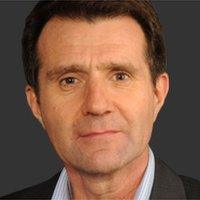Why China is fixated on the Moon
- Published
- comments
David Shukman visits an exhibition in Guiyang, southern China, that explores China's obsession with the Moon
The Moon could be a "beautiful" source of minerals and energy, a top Chinese scientist has told the BBC.
Exotic materials including helium-3 and the potential for solar power could prove invaluable for humankind, he says.
The comments come from Prof Ouyang Ziyuan of the department of lunar and deep space exploration.
His first interview with the foreign media provides insights into China's usually secretive space programme.
Prof Ouyang was speaking ahead of the first Chinese attempt to land an unmanned spacecraft on the lunar surface.
The Chang'e 3 lander is due to launch imminently, perhaps as soon as Sunday evening, UK time.
It will be the first to make a soft touchdown on the Moon since an unmanned Russian mission in 1976.
No humans have set foot on the lunar surface since America's Apollo missions ended in 1972.
Prof Ouyang is an adviser to the mission and his comments reveal the scale of Chinese thinking about the Moon.
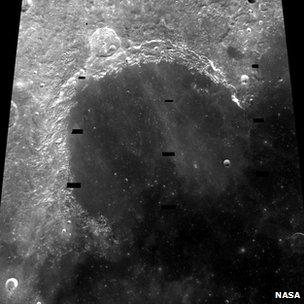
The Chang'e 3 lander is heading for a crater known as Sinus Iridum
He said the forthcoming venture would land in an ancient crater 400km wide called Sinus Iridum, thought to be relatively flat and clear of rocks, and explore its geology.
He explained that there were three motivations behind the drive to investigate the Moon.
"First, to develop our technology because lunar exploration requires many types of technology, including communications, computers, all kinds of IT skills and the use of different kinds of materials. This is the key reason," he told BBC News.
"Second, in terms of the science, besides Earth we also need to know our brothers and sisters like the Moon, its origin and evolution and then from that we can know about our Earth.
"Third, in terms of the talents, China needs its own intellectual team who can explore the whole lunar and solar system - that is also our main purpose."
After the first two Chang'e craft orbited the Moon, the next two missions will try to land on it and the following two will attempt to bring samples back to Earth.
Manned expeditions will then take place, according to Prof Ouyang.
"After all of this work, which is that China can make the achievement of arriving at the Moon and safely landing and that we can bring samples back; and once we finish all these unmanned projects, we will send Man there."
A rationale for this long-term programme is that "there are many ways humans can use the Moon", and he outlined a startling vision for its exploitation.
With no air on the Moon, solar panels would operate far more efficiently, he believes, and a "belt" of them could "support the whole world".
The Moon is also "so rich" in helium-3, which is a possible fuel for nuclear fusion, that this could "solve human beings' energy demand for around 10,000 years at least".
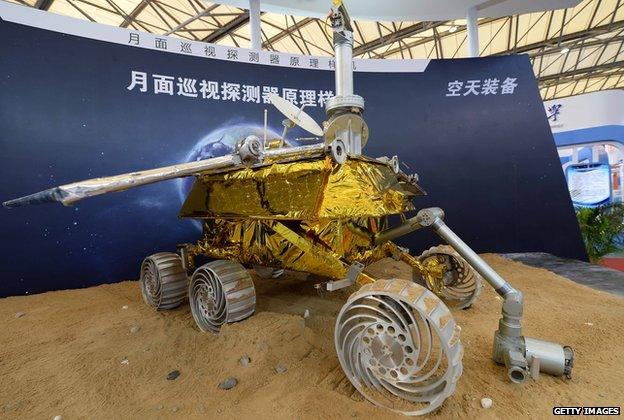
Chang'e 3 model: Not since the Soviets' Luna 24 mission has there been a soft landing
Prof Ouyang highlighted the combination of an extremely thin atmosphere and massive temperature extremes offering a unique possibility for manufacturing that does not exist on Earth.
He also spelled out the potential riches in lunar minerals and metals - a feature highlighted in an exhibition about the Moon which I visited in his home city of Guiyang.
"The Moon is full of resources - mainly rare earth elements, titanium, and uranium, which the Earth is really short of, and these resources can be used without limitation.
"But it's unnecessary to get them now because it's very costly."
Prof Ouyang summed up his vision for the goal of lunar exploration: "There are so many potential developments - it's beautiful - so we hope we can fully utilize the Moon to support sustainable development for humans and society."
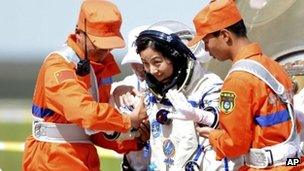
China is steadily developing its human spaceflight capability so it can put people on the Moon
Coming from a representative of a poorer, less ambitious nation, these ideas might be seen as purely wishful thinking.
But China has been methodically and patiently building up the key elements needed for an advanced space programme - from launchers to manned missions in Earth orbit to unmanned planetary craft - and it is investing heavily.
This comes as China is seen by neighbouring countries in Asia as flexing its muscles, most recently over control of airspace over the South China Sea. Chinese officials stress their desire to cooperate on space projects but lunar exploration is also regarded as a statement of national prowess.
Ouyang has himself been blunt about this in the past, as here in 2006: "Lunar exploration is a reflection of a country's comprehensive national power," he said in an interview with the official newspaper People's Daily. "It is significant for raising our international prestige and increasing our people's cohesion."
One leading British space scientist, Prof Richard Holdaway of the government-funded laboratory RAL Space, has long experience of working with China.
He believes China could have astronauts on the lunar surface by 2025.
"They started from a long way back but now they're catching up fast - they want to monitor what's happening on the ground, they want to be part of the analysis of climate change and a much bigger programme looking at the Moon for mining or as a staging post to other parts of the Solar System."
I asked him if the idea of a Chinese moonbase extracting minerals was remotely plausible.
"It's perfectly plausible from the technical point of view, absolutely plausible from the finance point of view because they have great buying power, so I think, yes, there's nothing at all to stop them doing that probably within something like 10 years.
So a great deal is riding on the Chang'e 3 launch - national prestige, the quest for technological prowess and the desire to harness all available natural resources.
If all goes according to plan, the spacecraft will take six days to reach the Moon and then face the challenge of a soft landing.
But it is clear that a successful mission will pave the way for the next boots to walk on the lunar surface to be worn by Chinese astronauts.
- Published26 November 2013
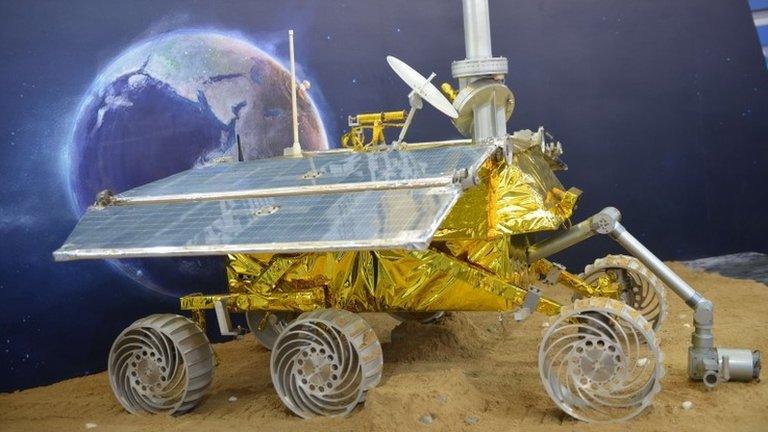
- Published26 September 2013
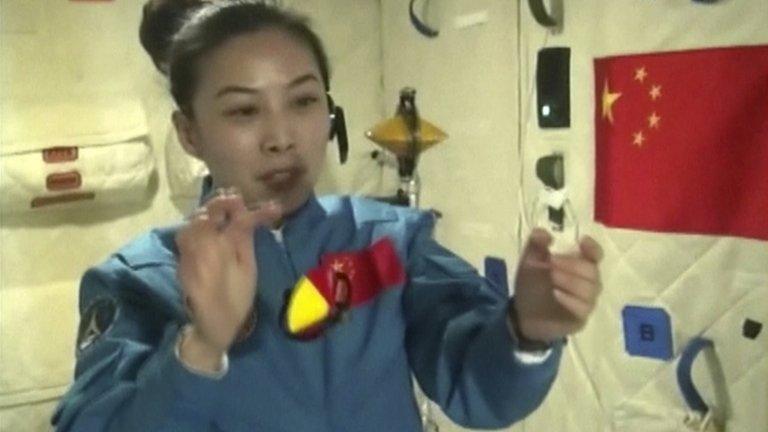
- Published26 June 2013

- Published20 June 2013

- Published29 June 2012
- Published29 July 2019
